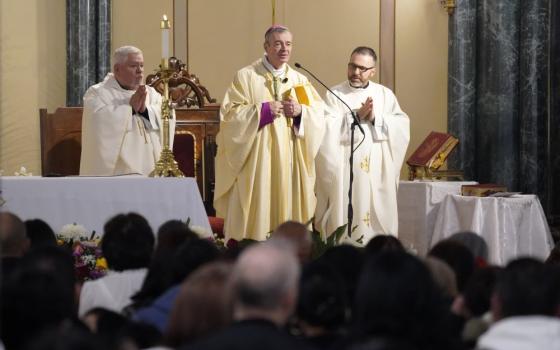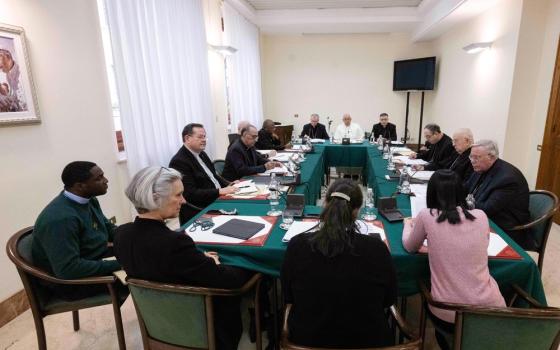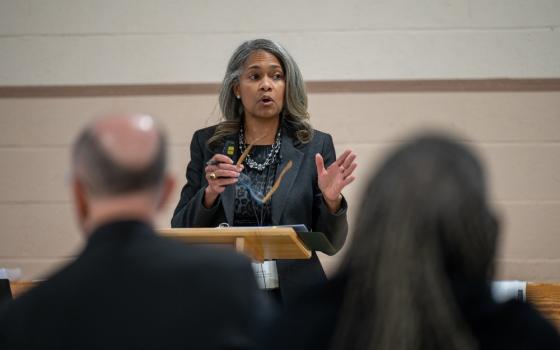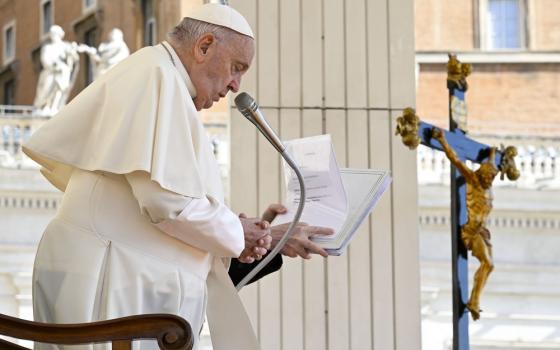ANALYSIS
Editor’s Note: Much has already been written about the “The Causes and Contexts of Sexual Abuse of Minors by Catholic Priests in the United States, 1950-2010,” commissioned by the U.S. bishops, conducted by the John Jay College of Criminology and released in May. Much of that has looked at the report from a particular stance toward clergy sex abuse, namely either an institutional view or an advocate’s view. That is why when Mary Gail Frawley O’Dea approached NCR to write a “dispassionate” review of this study, from a clinician’s viewpoint, we said yes.
Frawley-O’Dea is a clinical psychologist and the only mental health professional to address the U.S. bishops’ conference on the sexual abuse crisis at their 2002 Dallas meeting. The same year, she also addressed the Conference of Major Superiors of Men on the subject of sex abuse.
------------------------------------------------
The publication of the most recent John Jay study of sexual abuse in the church has been met by predictably impassioned binary responses. Church leaders seem to idealize the results, feeling vindicated in at least some of their responses to sexual abuse. Victims and advocates, on the other hand, lambaste the research as a dismissive invalidation of their pain. It is always difficult to speak dispassionately about sexual abuse; the crimes at issue involve passion, denial by perpetrators is standard fare, and brittle experiences of new betrayal are at the ready for victims expecting their suffering to be minimized. It is worth trying, however, to put passion aside temporarily to make room for reason. I hope to do a little of that here.
Before unpacking specific aspects of the John Jay study, it is important to put the entire project into a research and scholarly context.
It is what it is and it is not what it is not. The John Jay study is not “the” piece of research on the sexual abuse crisis; it is one contribution to the literature. Any topic as broad, long-lasting, and multilayered as the sexual abuse of children by priests over the course of 60 years -- the scope of the study -- and the failure of adequate responses to those crimes by others cannot be fully covered by one research project. Rather, it will take years of empirical research studies, clinical narratives, memoirs, theoretical books and papers that eventually may generate a coalescence of findings about exactly what happened and why.
It is a study conducted by criminologists. Criminology is one field. Like any science, it involves a set of principles, biases and methodologies, and a body of literature to draw from that is peculiar to that science. Criminologists view the world through a limited number of lenses. Psychologists, theologians, historians, sociologists and cultural anthropologists look at the world through their own sets of perspectives. No one field and no one study in any of these fields can be expected to tell a complete story. We need them all to do their work, as they surely will over the next years and decades.
Principal investigator Karen Terry and her team have generated some meaningful results, conclusions and recommendations that indeed shed light into a corner of the church that has long been shrouded in shadows.
Homosexuality:
Terry and her colleagues could not be clearer in their findings, which converge with well-accepted conclusions from other social science fields: There is no correlation between a homosexual identity and the sexual violation of a minor. Sexual abuse is a crime of opportunity, not of sexual identity. In fact, the period of decline in priestly sexual abuse corresponds with both the gaying and graying of the priesthood, although Terry does not make that connection explicitly. In any event, no Catholic pope, bishop, priest or layperson can in good conscience identify gay priests as the primary source of sexual abuse, even of boys.
Celibacy:
The John Jay study indicates that celibacy in and of itself is not correlated with sexual abuse. At the same time, it is of note that 80 percent of priests in residential treatment for any psychological problem, not just abuse, have been sexually active, mostly with adults. Further, most men who abused minors also were sexually active with adults. Combining these data with Richard Sipe’s ethnographic conclusions that, on any given day, only 50 percent of priests are observing celibacy, and with Andrea Celenza’s clinical observations that celibacy is a moving target for most priests, we have increasing reason to believe that celibacy is observed as much in the breach as in the practice.
Further, the John Jay researchers find correlations in the literature between sexual abuse and social isolation and loneliness, subjective states and vulnerabilities that might be alleviated were celibacy optional. It would be interesting, for example, to compare Catholic priests and married mainstream Protestant clergy on measures of loneliness and isolation.
The abuse was serious:
This John Jay study puts to rest any lingering dismissals of priestly sexual abuse as “just” fondling. Almost all priests with allegations of sexual abuse committed more than one kind of sexual violation and they included “explicit sexual activity.”
Abuse results in serious consequences for the victim:
Terry provides a comprehensive overview of the ways in which sexual abuse damages the victim and haunts him or her for decades. Never again can any Catholic claim ignorance about how devastating to the victim sexual abuse is.
Perpetrators are ‘us,’ not ‘them’:
The researchers discerned what has been found repeatedly in the literature on sexual offenders. There are no tests that reliably predict who will abuse and, on standard psychological assessments, abusers do not look more pathological than a “normal” population. Nor do they have more depression, anxiety or personality disorders than the rest of us. Three findings, however, suggest the need for careful evaluation during pre-seminary application processes. Priests from dysfunctional families, e.g., ones with substance abuse, were more likely than other priests to abuse later. Further, priests from families in which sex was viewed negatively and was not discussed also were more vulnerable to abusing later. Finally, priests who themselves had been sexually abused were more likely to offend. This latter conclusion should be viewed with caution. There are some studies that suggest that perpetrators may dishonestly claim abuse histories, suspecting -- often rightly -- that they will be judged less harshly if they claim prior abuse.
Importance of seminary formation:
The John Jay team illustrates profound changes in seminary formation occurring over the decades since 1950. It was not until 2005 that the Program of Priestly Formation outlined a deep consideration of human development and psychosexual development. This is appalling, of course, but the finding conforms to the speculations of people like Sipe, Jason Berry, Gene Kennedy, David Gibson, Donald Cozzens, and me that the lack of exposure to psychoeducation about emotions and sexuality ill-prepared seminarians to function maturely in their vocational careers.
Ongoing formation missing:
There is little ongoing assessment and formation for Catholic priests, especially after the first five years. Since most accused priests did not abuse for the first time until six to nine years after ordination, it suggests that the assessment and formation (re-formation?) of priests cannot stop, but must be something woven into the fabric of their lives over the entire course of their careers.
Abuse is a crime of opportunity:
An important finding of the John Jay study is that sexual abuse of a minor is primarily a crime of opportunity. Most abusing priests were neither confirmed pedophiles (consistently attracted to prepubescent children), nor confirmed ephebophiles (consistently attracted to pubescent and older minors). Rather, 42 percent of abusing priests were what Terry calls “generalists,” men who would abuse either gender of any age depending on availability of the victim.
Therefore ...:
A crucial recommendation of the John Jay study is for church authorities to implement and monitor strategies for minimizing the opportunities for a priest to abuse. The study offers few specifics, but windowed doors on every classroom, continued sex abuse prevention training, ensuring that at least one other adult is present whenever clergy and children are together, etc., are examples of opportunity-reducing actions. Terry points out that there is good literature available on “situational prevention models.”
The bishops did not respond well:
This report did not let the bishops off the hook. It did explain various reasons leading to inadequate responses, but explanations are not excuses. For example, Terry writes that police were called in only 14 percent of cases and then often after statutes of limitations had expired. She points out the many junctures along the way that the hierarchy could have done more and acknowledges that in some dioceses, there is still a reluctance to fully acknowledge the management and leadership failures inherent in the crisis. The report also states that centralized, hierarchical authority structures like that of the church are not conducive to organizational reform even when it is sorely needed. Further, the researchers agree with other writers who have indicated that victims, parents, church employees and other priests who came forward to allege suspicions about abuse or actual abuse often were dismissed or threatened by church officials.
The John Jay report confirms a number of important theses about the crisis already offered in the non-empirical literature. In addition, it provides empirically based insight about homosexuality, the difficulty in identifying perpetrators ahead of time, and the pastorally impoverished responses over a long period of time.
The new John Jay report also falls short in a number of areas, as I would expect any study of its scope to do.
Lack of qualifying language:
It is troublesome to me that Terry and her colleagues failed to qualify the limitations of the report or sufficiently use qualifying language. Much, not all, of the John Jay source material was data self-reported by bishops, priests and church-operated treatment centers. Self-reports in research are regularly viewed with skepticism because there is no way to validate the accuracy of what is being surveyed. Since we know from grand jury reports and lawsuits that dioceses and provincial officers have been derelict in sharing all that they know about the history of abuse in their domains, Terry should have expressed the potential limitations of self-reported data -- in any research and particularly in this study.
What the John Jay researchers know about perpetrating priests is also conditional because officials can only supply the records of priests who have been accused. Too often, the research team uses assertive language about the number of abusive priests or the number of victims rather than qualifying these as accused or reported perpetrators and only victims who have come forward. While acknowledging that abuse is both underreported and reported years after the fact, Terry does not convey tentativeness about her findings. There are reasonable, literature-based extrapolations that can be made to conclude that the actual number of victims over 60 years is closer to at least 35,000 than 11,000 and that there are priests who perpetrated but were never accused. In addition, priests already accused may well have had more victims who have never come forward. Terry should have included statements about the significant likelihood that the number of reported victims and of reported perpetrators are both understated.
The same absence of qualification applies to the report’s discussion about recidivism. If many perpetrators are never reported, it is likely that many more are reported only once although they have offended again. When Terry talks about priests who have only one victim, she again should have qualified that with some discussion of probable understatement.
‘Pedophile’ priests:
From a criminologist’s point of view, the distinction between generalist perpetrators versus specialist pedophiles or ephebophiles has meaningful importance. Many readers, however, interpreted the insistence that few priests were pedophiles as a minimization of what these men were: criminal sexual perpetrators who preyed upon the innocent and the vulnerable. It is not really reassuring that many of these priests were “generalists” who would violate whoever was handy at the moment, and the researchers could have emphasized the danger these men presented whatever they were called.
The past is still present:
John Jay’s casting of the sexual abuse crisis as “historical” may or may not be true as a term of art. Knowing that this report would be read by a wide spectrum of people with no particular social science training, however, generated a responsibility on the part of the John Jay team to carefully clarify what they meant. The crisis certainly is not “historical” for the thousands of victims who deal day in and day out with the consequences of sexual abuse eloquently outlined by Terry or who wait for lawsuits drawn out endlessly by defense lawyers with the permission of bishops. The present is the past for many survivors.
The researchers define the “crisis” as the sexual abuse itself. Most contributors to the field, however, have never defined the crisis or the scandal in this way. Rather, most view it as the hierarchy’s failure of pastoral leadership and appropriate response to both perpetrators and victims. As Terry herself acknowledges in the report, this continues to some extent. The report should have acknowledged the substantial literature in the field that defines the crisis as primarily a leadership failure, one that is ongoing in too many places.
The decline of abuse:
Terry’s assertion that the incidence of child abuse of all kinds has declined since the 1990s is borne out in other studies, particularly by David Finkelhor, who is cited by the John Jay report. Jones and Finkelhor report that child sexual abuse declined 53 percent in America between 1992 and 2007 for a variety of reasons, including advances in mood-stabilizing and impulse-controlling psychopharmacologies; a booming economy that lessened stress on individuals and families; increases in the numbers of law enforcement and child protection personnel; more aggressive prosecution and incarceration policies; growing public awareness about the problems; and new treatment options for family and mental health problems.
Within the church, the increasing numbers of gay priests, the aging of the priestly population, fewer children actively involved in church activities, increasing caution about allowing children to spend time alone with a priest (for example, on a vacation) -- all were likely to contribute to a decrease in sexual abuse by priests. Terry did not discuss these possibilities and seems to overattribute the likely decline of abuse in the church to the hierarchy’s development of better policies, policing, and response strategies. While these factors certainly contributed to decreasing numbers of sexual abuse victims, Terry had an obligation to discuss as fully the lack of a single cause of abuse decline as she did the lack of a single cause of occurrence.
They didn’t really ‘get it’:
John Jay’s assertion that the bishops failed to understand the scope of sexual abuse in the church or the damage it did to victims is not empirically supported in the report and simply is not credible. The Catholic church has had a sexual abuse problem with monks and priests since at least the Middle Ages and there have been numerous canonical and policy documents addressing the issue since then, often cautioning secrecy to protect the institution. In 1984, Dominican Fr. Thomas Doyle, Fr. Mike Peterson and Ray Mouton were scheduled to present their report to the bishops and were canceled by Boston Cardinal Bernard Law, suggesting an investment in not knowing what was available to be known.
Since Dallas, there have been more than a few reports of bishops keeping accused priests in ministry and, of course, the second Philadelphia Grand Jury Report details ecclesiastical mishandling of sexual abuse since 2002 that is all too familiar. Finally, if bishops really did not understand how terribly sacrilegious and devastating sexual abuse was, why did they work tirelessly to keep it secret? More than the average American man or woman, Catholic officials knew about sexual abuse and chose to protect the church and priests at the expense of souls entrusted to their care.
The media did it:
Terry and her colleagues suggest that the media has a particular ax to grind against the Catholic church and that they have ignored all along the progress the church has made in more effectively confronting abuse. The media indeed seems regularly to stress the provocative rather than the positive. At the same time, however, the John Jay report seems itself to ignore the many stories of church officials who minimized abuse and returned abusers to ministry well after the Five Principles were ostensibly in play. The Dallas Morning News published a three-month study in 2002 indicating that two-thirds of the bishops arriving for the seminal Dallas meeting had kept abusing priests in ministry. Only a year after the bishops’ Dallas meeting, Minneapolis-St. Paul Bishop Harry Flynn, chair of the Ad Hoc Committee on Sexual Abuse, denied requests from victims to speak to the bishops, saying they did not need to hear that again. If the media reports the facts and the facts of ecclesiastical maneuvers to minimize their own failures in the sexual abuse situation are there to be reported, it remains church authorities, not the media, who should be cited as derelict.
Where are the seminal sources?:
One of the more startling aspects of the John Jay report is its lack of a comprehensive bibliography. As scholars, Terry and her colleagues had an obligation to present a thorough review of the literature, pointing out when it agreed with or diverged from their findings. The report, to some extent understandably, focuses on criminology sources and cites the seminal works in that field, but it is impoverished in its cited familiarity with key sources in both the sexual abuse and Catholic sexual abuse crisis literatures. In the sexual abuse field, works by Christine Courtois, Glen Gabbard and Eva Lester, Richard Gartner, Mic Hunter, Judith Herman, Mike Lew, Diana Russell, Alan Sugarman, Bessel van der Kolk and colleagues, Gail Wyatt, and others are not cited. Similarly, the report does not cite the many who already have labored in the field of analyzing the church crisis and clergy abuse in general: Candace Benyei, Jason Berry, Frank Bruni and Elinor Burkett, Andrea Celenza, Donald Cozzens, Paul Dokecki, Eileen Flynn, Marie Fortune, David France, David Gibson, Myra Hildalgo, Mark Jordan, Gene Kennedy, Leslie Lothstein, Geoffrey Robinson, myself, and others. Since this is a study of “causes and context” of sexual abuse in the church, the omission of so many who have expended effort on exactly those issues is particularly disturbing. Terry may have confined herself to empirical literature, but in a study of context, it would be expected that she would also discuss the many and mostly convergent clinical, theoretical and narrative works on the topic.
I began this analysis stating that no one research study or narrative about the causes of the Catholic sexual abuse crisis can be definitive and criticisms can be lodged against any effort. Terry and her John Jay colleagues have made a valuable contribution to the literature, one that combines excellence and rigor with incompleteness and omissions. Such is the nature of research. The bishops, therefore, cannot point to this as the consummate and final analysis of their sexual abuse crisis nor should critics devalue the entire report because of its failings. Rather, we can appreciate that it is what it is and it is not what it is not.
[Mary Gail Frawley-O’Dea is coauthor of Treating the Adult Survivor of Childhood Sexual Abuse and coeditor of Predatory Priests, Silenced Victims.]



